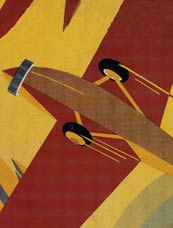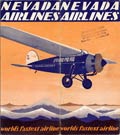|
LOCKHEED VEGA Model 5 NC/NR7954
WRECKED IN ALBUQUERQUE
HOW MUCH INFORMATION CAN YOU GET FROM ONE PHOTOGRAPH? READ ON.
This airplane is a Lockheed Vega Model 5 (S/N 24; ATC #unidentified
in the record, but probably #93) manufactured August 12,
1928 by Lockheed Aircraft Corporation, Burbank,
CA. It
left the factory with a Pratt & Whitney Wasp engine
(S/N 920) of unspecified HP. It was a five-place airplane. This
airplane was the original “Winnie Mae”.
It sold for $20,240 on November 14, 1928 to F.C. Hall, Chickasha,
OK. It had special paint and lettering, including “Winnie
Mae” for Hall’s daughter. It was flown
by Wiley Post for about six months.
We find the airplane at Tucson three times, the first two
on November 17th and December 17, 1928. Both times
this new airplane is piloted by Wiley Post. On
November 17th he is solo flying eastbound from Los Angeles,CA to Chickasha, OK. This is probably the ferry flight
of the new airplane from the factory at Burbank.
On December 17th, Post was carrying passenger Allen F. Prichett. They
are westbound from Chickasha to Los Angeles. There
was no purpose mentioned for this trip, but it was probably
on behalf of Hall’s business.
NC7594 was sold back to Lockheed Aircraft Corporation on May 7,
1929 and they passed it on to Nevada Airlines, Inc., Los
Angeles, CA on August 12, 1929. Roscoe
Turner was manager
of operations for Nevada. Besides flying Nevada Airlines
routes, NC7954 was flown on cross-country flights and in
the 1929 National Air Races by Turner. It was one of
the first Vegas to be fitted with both a NACA cowl and wheel
pants. It was named “Sirius”, and it is
pictured below (from page 46 of R.S. Allen). Both cowl and
pants are nicely shown. We might be looking at the airplane soon after it was tapped for Nevada Airlines service, because it appears that the landing gear struts are masked for painting. The final paint design is visible in the next image below. Allen (cited, left sidebar) describes the colors as black and silver. But a period color brochure, left, for Nevada Airlines shows a Lockheed Vega painted dark blue and white.
 |
Below, a unique photograph of NC7954 standing on a California small town street (note the shadow of a building from the other side of the street at lower left, and the lampost shadow, bottom center). The following three images are shared with us by Evan Johnson (cited, right sidebar). The flying surfaces of the airplane do appear to be silver, not white. Regardless of the color, notice the dust on the aft fuselage and wheel pants (with an arrow design now) showing some operations off unpaved airstrips, which were common at the time.
Lockheed Vega NC7954, Circa 1930
(Source: Johnson)
 |
Mr. Johnson states, "Here is Vega NC7954 at Death Valley Junction in 1930. It's parked in the town square which still looks about the same today. The town was built by Pacific Coast Borax Company as a support center for their mining operations in the area. You can see part of their name on the building behind NC7954 [in the original photo you can see P-A-C-I- on the building behind and below the right propeller blade]. My best guess is it had just brought in some parts that they needed in a hurry. The photo is from an old album that my father put together. He worked in purchasing for the Pacific Coast Borax Company in Death Valley Junction in the early 1930's."
Indeed, this location does look pretty much the same today. Below is a photo sent to us by Mr. Johnson on June 11, 2009. Compare it with the one above and note the obvious similarities, including the archways on the left side of the building. The blue sign on the building at far right reads "Amargosa Opera House" (see photograph of Opera House interior, below). The principal of the Opera House, Marta Becket, passed away January 30, 2017, age 92. The link leads to her obituary that appeared in The New York Times (NYT), February 3, 2017. I you discover the link inoperative, please let me KNOW.
Approximate Location Today of 1930 Airplane Photograph
(Source: Johnson)
 |
Mr. Johnson says about his photograph, "...for your amusement I have attached a photo I took today at the exact site of the 1930 NC7954 photo. Check the background second stories and the original curb behind my Corvette. Although it looks nice, I never saw another person and nothing appears to be happening in the area."
Below, a photograph of the inside of the Amargosa Opera House, from The New York Times, February 3, 2017.
Amargosa Opera House, Death Valley Junction, CA (Source: NYT)
 |
To compensate for those times when her real audience was sparse, principal Becket painted an audience on the walls so she would be sure to always play to a full house. According to her obituary, she did the painting and sewed the curtains.
Photographer Johnson, ca. 1930's
(Source: Johnson)
 |
To continue, given that we don't have an exact date for the original photograph, a good bet is the airplane is pictured in Death Valley Junction between Nevada Airlines service and a three-year life of racing in the hands of its next owner (read more about that below). Part of our logic is that Nevada Airlines filed for bankruptcy on December 12, 1929 and their four Vegas were returned (repossessed?) to Lockheed. Once the airplanes were returned they had their airline markings removed and they were offered for sale.
An interesting aside are the two wagon chassis at the left of the 1930 image. These would be from the "20 Mule Team" borax wagons used to haul borax ore out of Death Valley. The wheels, seven-feet in diameter at the rear and five-feet at the front, were encased in iron "tires" one inch thick. Although the wagons were not in use in the 30's, they probably remained on the town square as an historic artifact of the borax business. The Pacific Coast Borax Company (long since merged into the United States Potash Corporation) still supplies half the world's needs for borax products.
At right, Mr. Johnson's father, whose album the airplane photograph came from. He is standing in one of the archways of the Company's building. Note he has his hand on a column finial, which is the same shape as the finials on the columns visible to the right of the airplane's rudder, above. If you're old enough to remember, listen to the screen door slam.
Under magnification, we compared his father with the person in the photograph standing by the airplane door. Although the person next to the door appears to wear no eyeglasses, they could be the same person (same build; same hairline; same posture; double belt loops on his trousers to the right of the buckle). This conjecture is made even more difficult by the fact that the person by the door looks a lot like Art Goebel, who purchased NC7954 that year (see below).
Further, from the image below, we can place the exact location of this image in the town. Mr. Johnson says, "I'm 100% [certain] that it was taken where shown in blue in the attached 1995 aerial shot [below]. The curb is the southern edge of the 'town square'. And that long building (left) behind NC7954 is [the] Pacific Coast Borax office. Also on the right you can see the building that is now the Amargosa Opera House. I don't know if the airstrip was there in 1930. I think the little air traffic they had just landed on the highway and parked in town. It was 'a remote company town'. Also, the highways were good for several different wind directions."
Further still, Mr. Johnson calculates, "... it's early morning with long shadows from the sun in the east. I calculated 7AM based on the latitude and the lamp pole shadow [angle] to true north. Then, I calculated that the sun angle above the horizon was 33 degrees using a lamp pole height of 20' from another photo. That's pretty high for 7AM at 36 deg north. So, based on the airplane paint and the lamp pole shadow, I would say the photo was taken at 7AM in the spring of 1930." This approximate date agrees with the ownership status of the airplane described above.
Modern, 1995 Aerial Photograph of Death Valley Junction, CA
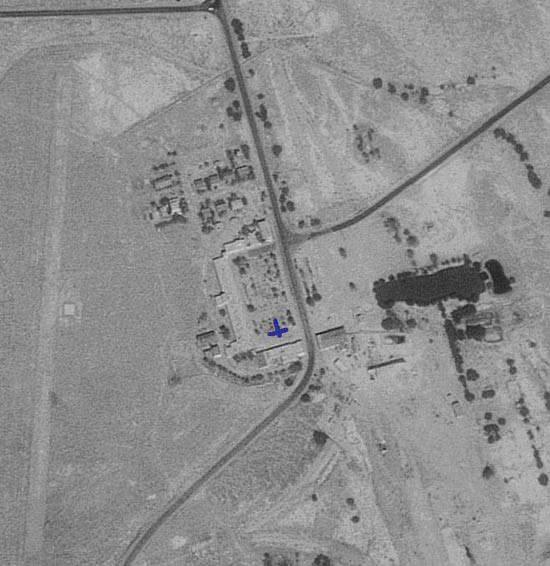 |
Regarding the Amargosa Airport and runway at the left of the image, it is runway 17/35, 1,625 x 50 feet. It is still an operating airport. The surface was natural soil with no special hardening treatment. But one source stated it is now concrete. It is owned and maintained today by the Amargosa Opera House, Inc. and is closed to public traffic. Permission must be granted ahead of time for landing. The square shape to the east of the runway is a 40 x 40 foot helicopter pad. I could not find a date of origin of the airport. Does anyone KNOW? The FAA information for the airport states, "ESTABD PRIOR TO 5/15/59."
Now, back to our airplane. On August 23, 1930, the airplane was sold
to Capt. Arthur
C. Goebel, Los Angeles, CA. He modified
it for use in the 1930 National
Air Races (race #62). It was converted to a single-place seating configuration and a “NR” registration
and flown that way until 1934. He flew it to second place
in the men's nonstop derby, Los Angeles to Chicago, IL, during
the 1930 races. His prize money was $4,500. Below, right, is an image
(from page 50 of R.S. Allen) of the airplane in new paint
and numbers as flown by Goebel. It is easy to conjecture that all the work to fashion the airplane to Goebel's needs, conversion to single-place seating, installation of different fuel tanks, repainting, all took place between Nevada Airline's bankruptcy in December 1929 and Goebel's first race with it at the end of August 1930. All the work probably took place simultaneously with the bill of sale being recorded with the Civil Aviation Authority.
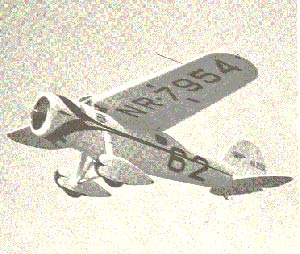 |
Now, without further ado, comes NR7954 to Tucson for the third time on Wednesday, October 7, 1931, flown by Goebel about a year
after he purchased it. Now, in October,
he was flying NR7954 cross-country solo from New York, NY to
Los Angeles. There is no indication in the Register regarding the purpose of his flight, or from which New York airport he departed. The airplane looked like the image at right (probably without the race number 62).
Below is another, larger photograph of NR7954, this time wearing race number 129. This photo comes to us courtesy of Tim Kalina. He says about his photo, "Note the race number, 129, on the rear fuselage which may indicate it was involved in an air race. And the covered cabin windows suggest that it was fitted with long-range cabin fuel tanks, which may indicate a long-distance race such as the Bendix." It appears to have the same paint scheme and covered windows as the image at right. It wore race number 129 probably during the 1931 Bendix Race from Los Angeles to Cleveland, OH. Goebel placed 5th in that race, out of the money, flying a Lockheed which was probably NR7954.
Lockheed NR7954, Date & Location Unknown (Source: Kalina)
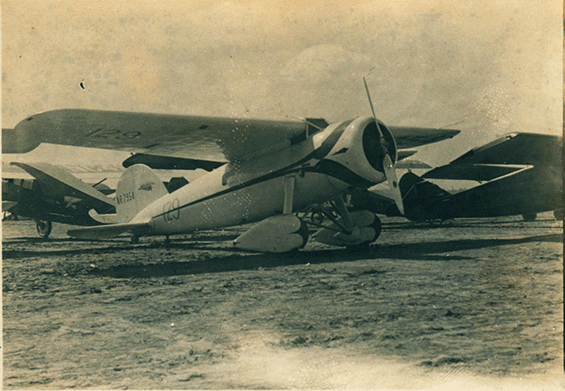 |
NR7954 was reconverted to a five-place airplane by Gray-Oviatt
Airplane Service, Van Nuys, CA as of February 1934, and the “NC” registration
was restored.
According to the NASM record (cited left sidebar) NC7954 was next purchased on December 19, 1936 by Laura Ingalls,
Great Neck, NY. It had Wasp SC-1 engine S/N 1533 installed. Ingalls
flew it for about five years. On August 11, 1941, it
was involved in an accident in Albuquerque, NM. The NASM data card reports, “due
to normal wear & tear, right side of landing-gear failed
on normal landing. Right wing dragged and all gear
failed. Engine torn loose, fuselage broke in two at
#4 bulkhead ring.” Pilot Ingalls suffered minor
injuries. Below is a photograph of the wreck of NC7954 at Albuquerque from the Alberts reference in the left sidebar. Ingalls was carrying isolationist leaflets for aerial dispersal. Painted on the fuselage is "No A.E.F.," meaning no American Expeditionary Force (in Europe).
Lockheed NR7954, Albuquerque, NM, August 11, 1941 (Source: Ref. Cited)
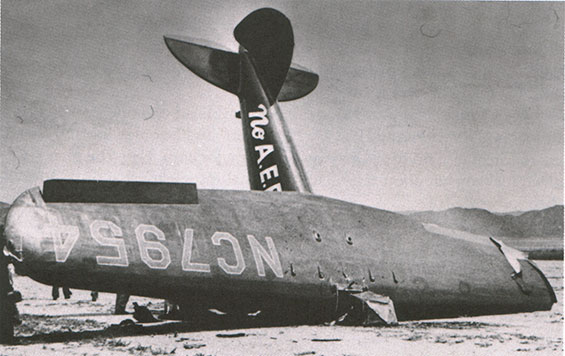 |
Please direct your browser to Ingalls' link at the Parks Airport Web site. There you will find conjecture regarding the legality of her flight to Albuquerque. Alberts' text srrounding the accident, and another photograph, suggest that Ingalls was not injured.
---o0o---
THIS PAGE UPLOADED: 04/11/06 REVISED: 09/29/07, 11/07/07, 11/25/08, 11/27/08, 06/11/09, 10/30/15, 01/06/16, 02/08/17, 12/09/19
|

